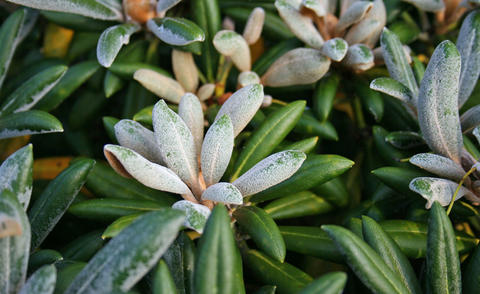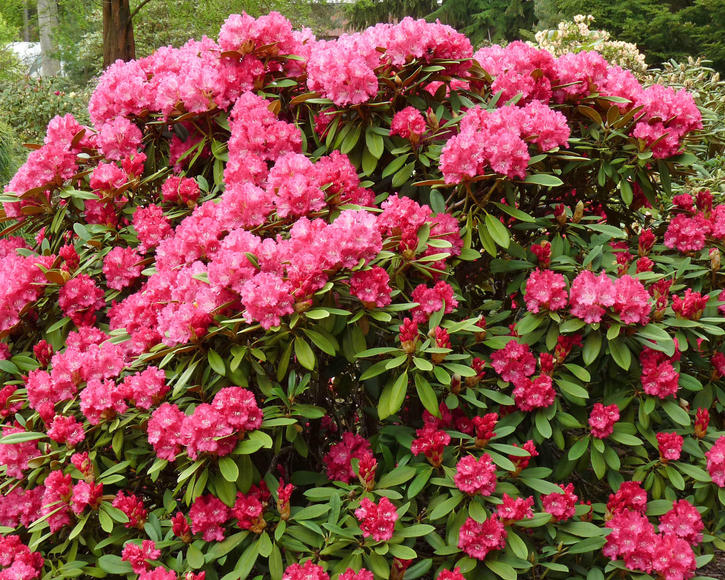Yakushimanum Rhododendron
Dense flowering, compact growth, winter hardy and sun-tolerant: Yakushimanum rhododendrons are especially popular among those of us with smaller gardens.
Factsheet
- Growth type
-
- Deciduous wood
- Small shrub
- Growth height (from)
- from 80 cm to 100 cm
- Growth width (from)
- from 100 cm to 150 cm
- Growth characteristics
-
- spherical
- sweeping
- upright
- tight
- bushy
- Flower color
-
- purple
- yellow
- red
- pink
- white
- Flowering time (month)
-
- May to June
- Flower shape
-
- corymbus grapes
- Leaf color
-
- green
- page format
-
- linear to linear lanceolate
- linear-lanceolate
- Sheet properties
-
- evergreen
- Fruit shape
-
- Capsule
- Light
-
- sunny to semi-shade
- Soil type
-
- sandy to loamy
- Soil Moisture
-
- fresh to humid
- ph value
-
- weakly acidic to acidic
- Lime compatibility
-
- sensitive to lime
- Nutrient requirements
-
- nutrient-rich
- Humus
-
- rich in humus
- Decorative or utility value
-
- Flower Decoration
- Leaf ornaments
- Toxicity
-
- non-toxic
- Winter Hardness
-
- hardy
- Climate zones according to USDA
-
- 6
- Use
-
- Single position
- Group planting
- Planters
- Garden style
-
- Flower garden
- Roof Garden
- patio
- Japanese Garden
- Rhododendron garden
- Pot garden
- Forest Garden
Yakushimanum rhododendrons come from the small island of Yakushima off the southern coast of the Japanese island Kyushu. Here, Rhododendron yakushimanum grows in a small, rainy and mountainous area 3,937 to 5,905 feet above sea level - winter hardiness is an essential requirement for survival here. The Yakushimanum rhododendron is just one of thousands of species in the Rhododendron genus. It first came to America in the 1930s. Here, its winter hardiness, generous blooms, stocky growth and love of full sun made it popular with many enthusiasts. The original wild variety has been crossed with many other large-flowered rhododendron varieties, creating the wealth of Yakushimanum hybrids we can choose from today.
Evergreen Yakushimanum rhododendrons grow slowly and remain very compact, not exceeding 3.2 feet in height. They tend to form a dense dome that’s 50% wider than it is tall. Its decorative buds with white-gray fuzz and velvety leaves are particularly eye-catching.
The linear to lanceolate leaves curve downwards and are 1.97 to 3.94 inches long. To begin with, the buds feature a white felt-like covering on both sides. Later on, only the underside is covered with a light brown felt. This felt also helps them flourish in the sun and continental climates - locations that most rhododendrons avoid as they prefer dappled shade and high humidity. The alternating leaves tend to be densely arranged on the shoots. The full margin leaves are undivided, some matt and some glossy. Their rich green coloring makes them attractive all year round, but some varieties are slightly gray in tone.

All Yakushimanum hybrids are exceptionally decorative and have large flowers, blooming from late April to early June depending on the variety. As with all rhododendrons, the flowers cluster on corymbs, with individual flowers being rare. The tubular, funnel or bell-shaped crowns consist of five to ten connected petals. The color of the mostly pastel flowers often changes over time: The bud is intensely colored but the flower lightens as time goes on.
The very fine seeds are contained in an upward-facing capsule that becomes woody.
The Yakushimanum rhododendron tolerates full sun as well as partial shade, but the soil must be sufficiently moist. Protection from wind and sun are particularly advisable while the plants are still young.
Acidic, rich in humus, loose, water-permeable and air-permeable: that’s the perfect soil for Rhododendron yakushimanum. There are also varieties that are grown on an Inkarho base, allowing them to grow in limey or even alkaline soil. However, they will not tolerate waterlogging.
Yakushimanum hybrids can be planted and cared for like any other rhododendrons.

As many Yakushimanum rhododendrons grow in the sun, you should pay particular attention to watering as well as mulched soil to retain moisture.
Yakushimanum hybrids grow so compactly that pruning is generally not required. Only if the plant is losing leaves does it make sense to cut back the Rhododendron in late spring. To do so, cut back all main shoots with short side shoots. Flowering will take at least a year after this.
Due to its compact growth, Yakushimanum rhododendron is ideal for small gardens. Its timeless look means it will fit into any ambience. It will even flourish in containers on terraces, roof gardens and balconies as well as paved courtyards. In winter, you must ensure that the root ball does not dry out or freeze.
Yellow, purple, red, white - Yakushimanum hybrids offer a range of mostly pastel-colored flowers. Many varieties are pink, but experts warn that not all are good choices. Here are a few examples of promising varieties: Rhododendron yakushimanum ‘Anuschka’ boasts a bright red at the edges with a paler throat and dark red markings. ‘Babette’ features a delicate shade of yellow with a red basal spot. ‘Fantastica’ stands out with its intense red coloring. ‘Flava Rosea’ alternates between light yellow and pink coloring. Purple-pink ‘Tatjana’ is a particularly robust, heat-tolerant and sun-tolerant variety. ‘Arabella’stands out with its delicate pink and dark red coloring. Ruby-red ‘Polaris’ is especially suited to tough climates, and ‘Pink Cherub’ stands out thanks to the contrast between its purple-red and almost white coloring.
Yakushimanum rhododendrons can be grafted using cuttings from the variety ‘Cunningham’s White’ or a lime-tolerant Inkarho base. Cultivators are increasingly relying on meristem-propagated rhododendrons. If you have time, you could simply try layering. This entails securing a low-level shoot in the ground. Once roots have formed, the new plant can be separated from the parent.
Shoot dieback, the Rhododendron leafhopper , Otiorrhynchus weevils: Yakushimanum hybrids are plagued by anything that plagues other rhododendrons.

